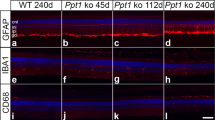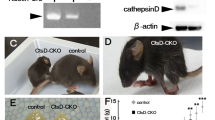Abstract
The neuronal ceroid lipofuscinoses (NCLs) are a genetically heterogeneous group of progressive neurodegenerative disorders characterized by the accumulation of autofluorescent lipopigment in various tissues1. Progressive epilepsy with mental retardation (EPMR, MIM 600143) was recently recognized as a new NCL subtype2 (CLN8). It is an autosomal recessive disorder characterized by onset of generalized seizures between 5 and 10 years, and subsequent progressive mental retardation3. Here we report the positional cloning of a novel gene, CLN8, which is mutated in EPMR. It encodes a putative transmembrane protein. EPMR patients were homozygous for a missense mutation (70C→G, R24G) that was not found in homozygosity in 433 controls. We also cloned the mouse Cln8 sequence. It displays 82% nucleotide identity with CLN8, conservation of the codon harbouring the human mutation and is localized to the same region as the motor neuron degeneration mouse, mnd, a naturally occurring mouse NCL (ref. 4). In mnd/mnd mice, we identified a homozygous 1-bp insertion (267-268insC, codon 90) predicting a frameshift and a truncated protein. Our data demonstrate that mutations in these orthologous genes underlie NCL phenotypes in human and mouse, and represent the first description of the molecular basis of a naturally occurring animal model for NCL.
This is a preview of subscription content, access via your institution
Access options
Subscribe to this journal
Receive 12 print issues and online access
$209.00 per year
only $17.42 per issue
Buy this article
- Purchase on Springer Link
- Instant access to full article PDF
Prices may be subject to local taxes which are calculated during checkout





Similar content being viewed by others
References
Santavuori, P. Neuronal ceroid-lipofuscinoses in childhood. Brain Dev. 10, 80–83 (1988).
Haltia, M. et al. CLN8: Northern epilepsy. in The Neuronal Ceroid Lipofuscinoses (Batten's Disease) (eds Goebel, H.H., Mole, S.E. & Lake, B.D.) 117–121 (IOS Press, Amsterdam, 1999).
Hirvasniemi, A., Lang, H., Lehesjoki, A.-E. & Leisti, J. Northern epilepsy syndrome: an inherited childhood onset epilepsy with associated mental deterioration. J. Med. Genet. 31, 177–182 (1994).
Bronson, R.T., Lake, B.D., Cook, S., Taylor, S. & Davisson, M.T. Motor neuron degeneration of mice is a model of neuronal ceroid lipofuscinosis (Batten's disease). Ann. Neurol. 33, 381–385 (1993).
Bonaldo, M.F. et al. Selection of cDNAs using chromosome-specific genomic clones: application to human chromosome 13. Hum. Mol. Genet. 3, 1663–1673 (1994).
de la Chapelle, A. & Wright, F.A. Linkage disequilibrium mapping in isolated populations: the example of Finland revisited. Proc. Natl Acad. Sci. USA 95, 12416–12423 (1998).
Messer, A. & Flaherty, L. Autosomal dominance in a late-onset motor neuron disease in the mouse. J. Neurogenet. 3, 345–355 (1986).
Messer, A., Strominger, N.L. & Mazurkiewicz, J.E. Histopathology of the late-onset motor neuron degeneration (Mnd) mutant in the mouse. J. Neurogenet. 4, 201–213 (1987).
Messer, A. & Plummer, J. Accumulating autofluorescent material as a marker for early changes in the spinal cord of the Mnd mouse. Neuromuscul. Disord. 3, 129–134 (1993).
Pardo, C.A., Rabin, B.A., Palmer, D.N. & Price, D.L. Accumulation of the adenosine triphosphate synthase subunit C in the mnd mutant mouse. A model for neuronal ceroid lipofuscinosis. Am. J. Pathol. 144, 829–835 (1994).
Messer, A., Plummer, J., Wong, V. & Lavail, M.M. Retinal degeneration in motor neuron degeneration (mnd) mutant mice. Exp. Eye Res. 57, 637–641 (1993).
Kyte, J. & Doolittle, R.F. A simple method for displaying the hydropathic character of a protein. J. Mol. Biol. 157, 105–132 (1982).
Nakai, K. & Kanehisa, M. A knowledge base for predicting protein localization sites in eukaryotic cells. Genomics 14, 897–911 (1992).
Savukoski, M. et al. CLN5, a novel gene encoding a putative transmembrane protein mutated in Finnish variant late infantile neuronal ceroid lipofuscinosis. Nature Genet. 19, 286–288 (1998).
The International Batten Disease Consortium. Isolation of a novel gene underlying Batten disease, CLN3. Cell 82, 949–957 (1995).
Hellsten, E., Vesa, J., Olkkonen, V.M., Jalanko, A. & Peltonen, L. Human palmitoyl protein thioesterase: evidence for lysosomal targeting of the enzyme and disturbed cellular routing in infantile neuronal ceroid lipofuscinosis. EMBO J. 15, 5240–5245 (1996).
Sleat, D.E. et al. Association of mutations in a lysosomal protein with classical late-infantile neuronal ceroid lipofuscinosis. Science 277, 1802–1805 (1997).
Porter, J.C., Messer, A. & Peterson, A. The motor neuron degeneration (mnd) gene acts intrinsically in motor neurons and peripheral fibroblasts. Mol. Cell. Neurosci. 9, 185–193 (1997).
Hirvasniemi, A., Herrala, P. & Leisti, J. Northern epilepsy syndrome: clinical course and the effect of medication on seizures. Epilepsia 36, 792–797 (1995).
Messer, A., Plummer, J., MacMillen, M.C. & Frankel, W.N. Genetics of primary and timing effects in the mnd mouse. Am. J. Med. Genet. 57, 361–364 (1995).
Ranta, S. et al. High-resolution mapping and transcript identification at the progressive epilepsy with mental retardation locus on chromosome 8p. Genome Res. 7, 887–896 (1997).
McCarthy, L.C. et al. A first-generation whole genome-radiation hybrid map spanning the mouse genome. Genome Res. 7, 1153–1161 (1997).
Rost, B., Casadio, R., Fariselli, P. & Sander, C. Transmembrane helices predicted at 95% accuracy. Protein Sci. 4, 521–533 (1995).
Bairoch, A., Bucher, P. & Hofmann, K. The PROSITE database, its status in 1997. Nucleic Acids Res. 25, 217–221 (1997).
Rost, B., Sander, C. & Schneider, R. PHD—an automatic mail server for protein secondary structure prediction. Comput. Appl. Biosci. 10, 53–60 (1994).
Acknowledgements
We thank the EPMR families for their cooperation; T. Alitalo and J. Kere for providing Finnish control DNA samples; M. Fox for FISH analysis of BAC clones; A. Kerrebrock and E. Lander for the background work on the genetic/physical map of the mnd critical region; and M. Gardiner for the critical reading of our manuscript. This study was supported by The Academy of Finland, The Sigrid Juselius Foundation, The Ulla Hjelt Foundation, The Finnish State Grant TYH8310, the Children's Brain Disease Foundation, NIH Grant NS29110 and the Wellcome Trust, UK (054606/Z/98/Z).
Author information
Authors and Affiliations
Corresponding author
Rights and permissions
About this article
Cite this article
Ranta, S., Zhang, Y., Ross, B. et al. The neuronal ceroid lipofuscinoses in human EPMR and mnd mutant mice are associated with mutations in CLN8. Nat Genet 23, 233–236 (1999). https://doi.org/10.1038/13868
Received:
Accepted:
Issue Date:
DOI: https://doi.org/10.1038/13868
This article is cited by
-
Emerging new roles of the lysosome and neuronal ceroid lipofuscinoses
Molecular Neurodegeneration (2019)
-
Current and Emerging Treatment Strategies for Neuronal Ceroid Lipofuscinoses
CNS Drugs (2019)
-
CLN8 is an endoplasmic reticulum cargo receptor that regulates lysosome biogenesis
Nature Cell Biology (2018)
-
Exome sequencing identifies a novel homozygous CLN8 mutation in a Turkish family with Northern epilepsy
Acta Neurologica Belgica (2017)
-
A rare homozygous MFSD8 single-base-pair deletion and frameshift in the whole genome sequence of a Chinese Crested dog with neuronal ceroid lipofuscinosis
BMC Veterinary Research (2014)



